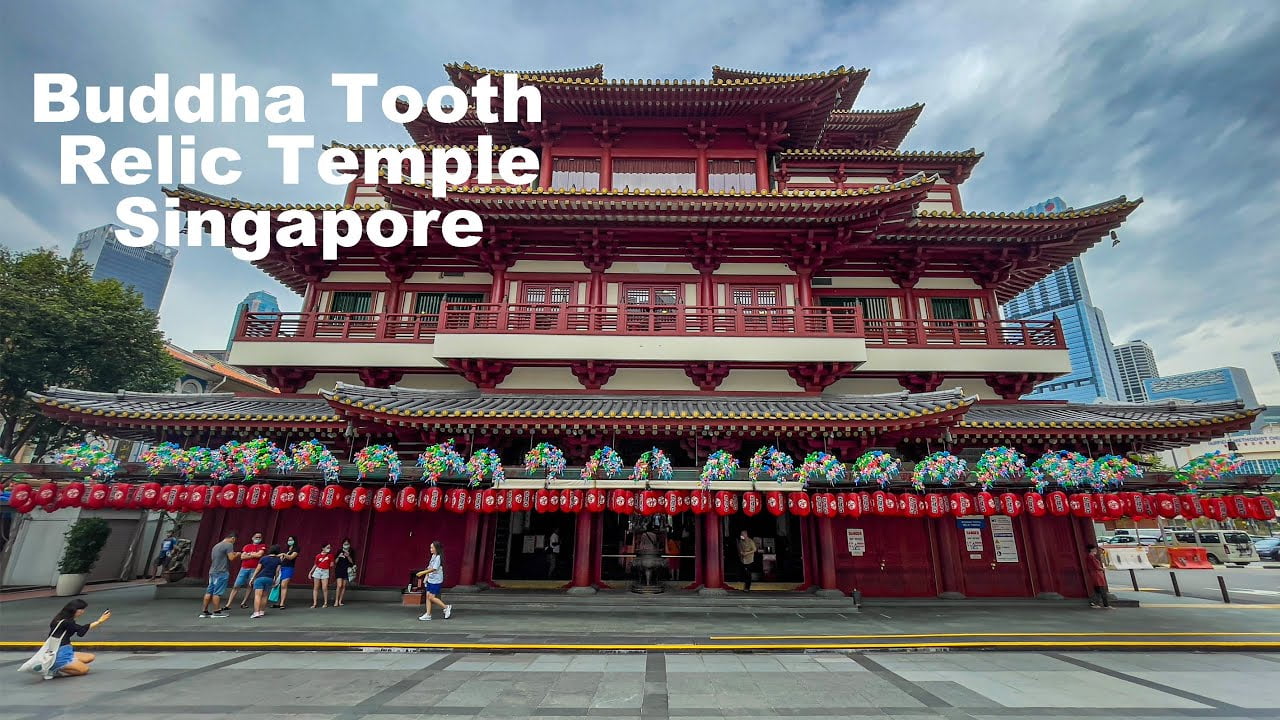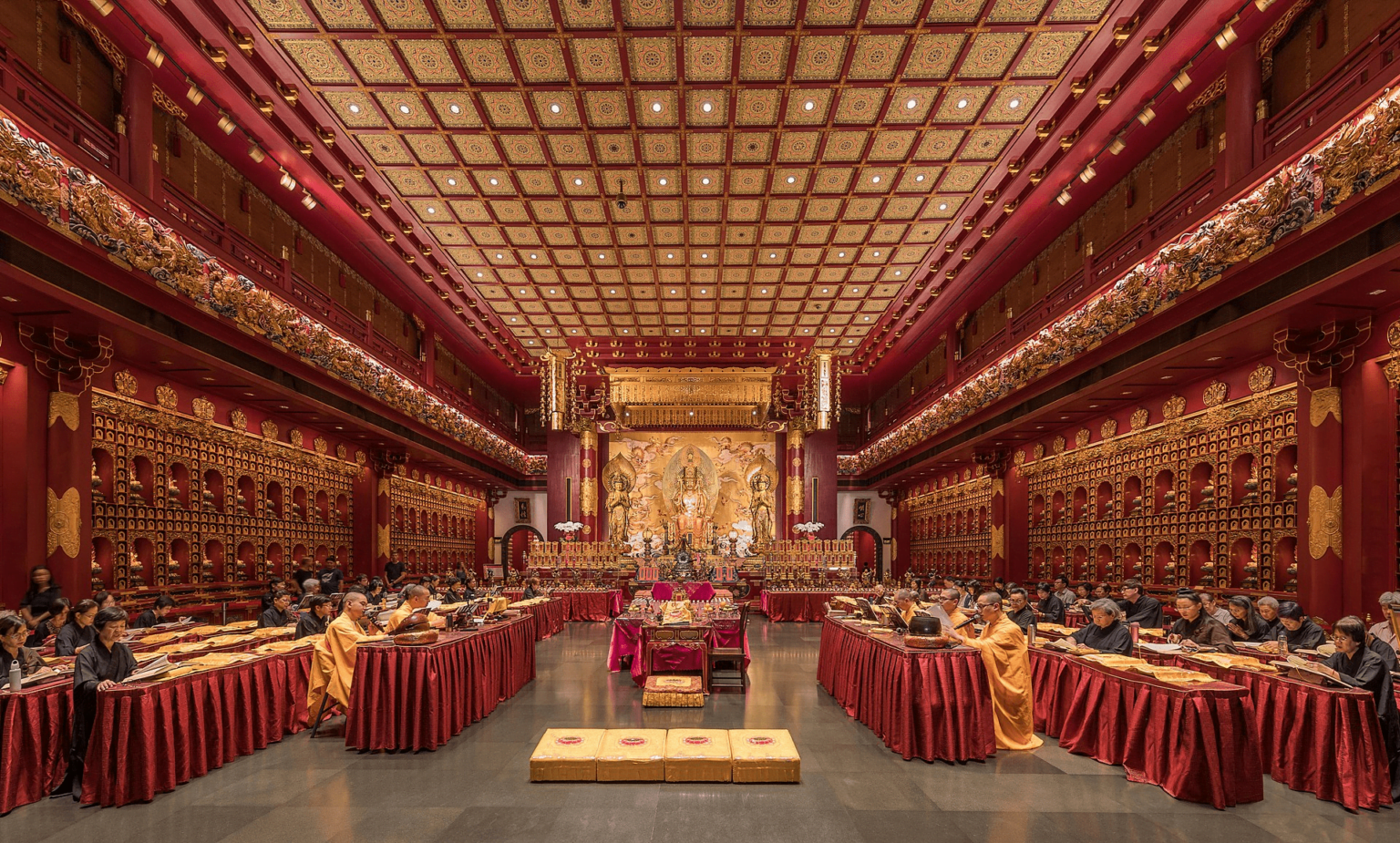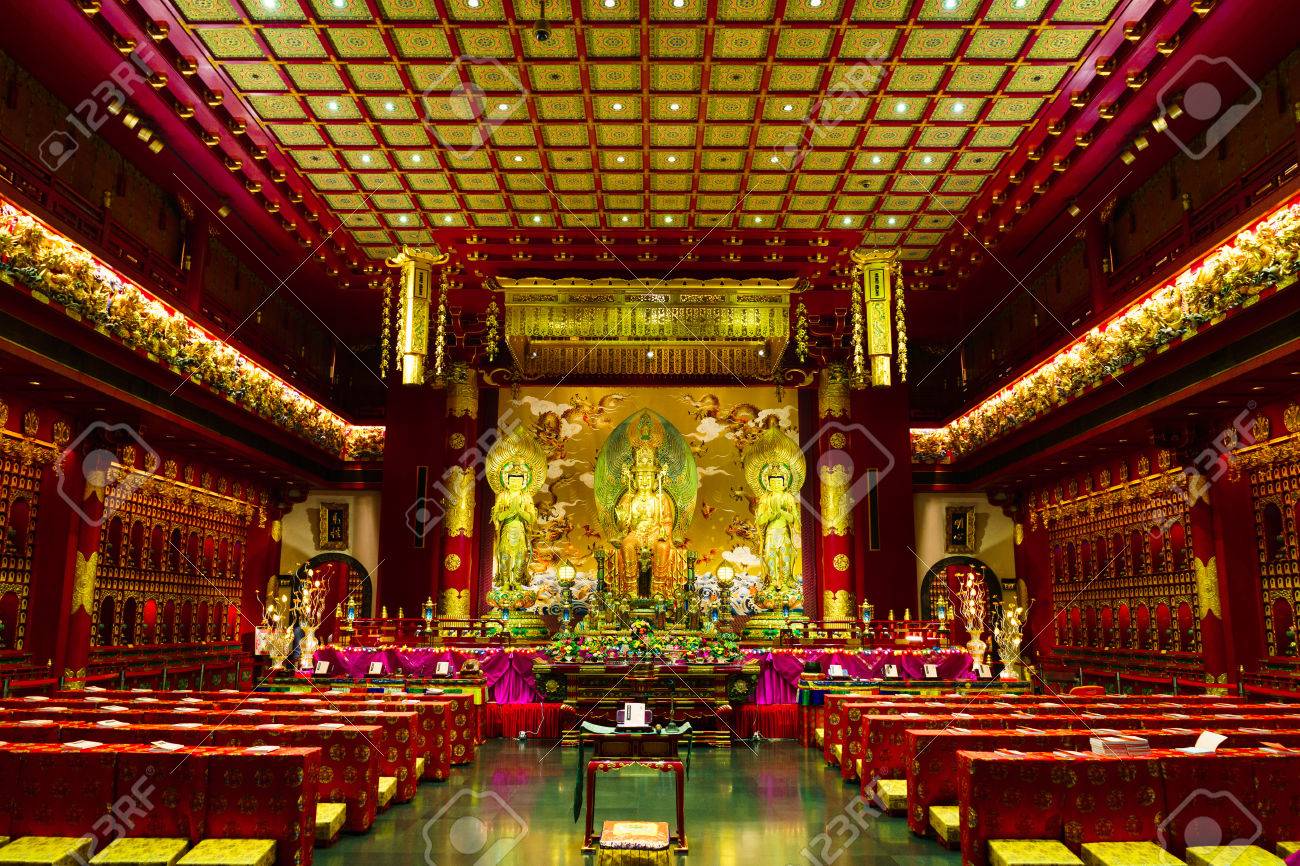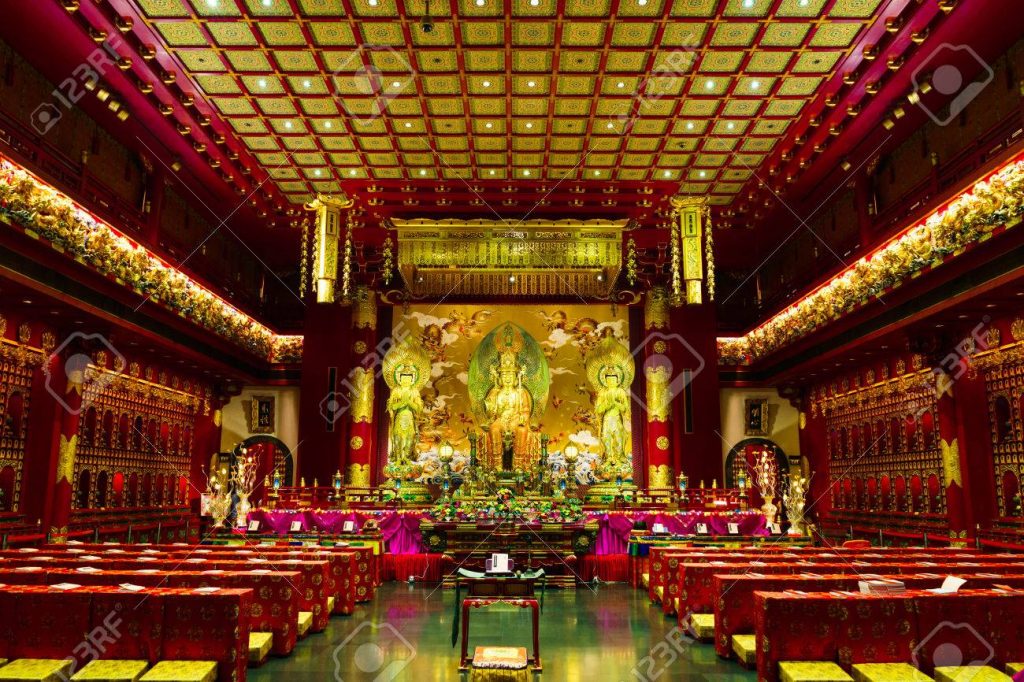The Buddha Tooth Relic Temple and Museum, located in the heart of Chinatown, Singapore, is a remarkable landmark that stands as a testament to the rich cultural and religious heritage of the city.
This grandiose temple, completed in 2007, is dedicated to the Sacred Buddha Tooth Relic, which is enshrined within a stupa made of gold. The temple is not only a place of worship but also a cultural and educational institution, offering visitors an immersive experience into Buddhist art, culture, and history.
This review will delve into various aspects of the temple and museum, including its architecture, cultural significance, visitor experience, and the overall impact it has on both locals and tourists.

Buddha Tooth Relic Temple and Museum Reviews: Architectural Marvel
The Buddha Tooth Relic Temple and Museum is an architectural marvel that draws inspiration from the Tang Dynasty. The temple’s design is a blend of traditional Chinese architecture and Buddhist elements, creating a visually stunning and spiritually uplifting environment.
The four-story building is adorned with intricate carvings, statues, and artworks that depict various aspects of Buddhist mythology and history.

Exterior Design
The exterior of the temple is a sight to behold, with its multi-tiered pagoda-like structure and ornate decorations. The roof is adorned with dragon motifs and other traditional Chinese symbols, which are believed to ward off evil spirits and bring good luck. The entrance is flanked by majestic guardian statues, welcoming visitors into the sacred space.
Interior Design
The interior of the temple is equally impressive, with each floor serving a different purpose. The first floor houses the Maitreya Hall, where visitors can offer their prayers and seek blessings.

The second floor is home to the Sacred Buddha Tooth Relic, enshrined within a golden stupa that weighs 3.5 tons. The third floor features the Buddhist Culture Museum, which showcases a vast collection of Buddhist artifacts, scriptures, and artworks. The fourth floor, known as the Pagoda of 10,000 Buddhas, is a serene meditation hall that offers a peaceful retreat for practitioners and visitors alike.
Cultural and Religious Significance
The Buddha Tooth Relic Temple and Museum holds immense cultural and religious significance for the Buddhist community in Singapore and beyond. The temple serves as a spiritual sanctuary where devotees can practice their faith, seek enlightenment, and connect with their inner selves. The presence of the Sacred Buddha Tooth Relic adds to the temple’s sanctity, making it a revered pilgrimage site for Buddhists from all over the world.
The Sacred Buddha Tooth Relic
The Sacred Buddha Tooth Relic is believed to be one of the teeth of Gautama Buddha, the founder of Buddhism. According to Buddhist tradition, the relic was discovered in a collapsed stupa in Myanmar and was later brought to Singapore. The relic is enshrined within a golden stupa, which is a symbol of the Buddha’s enlightenment and his teachings. The stupa is encrusted with precious stones and surrounded by intricate carvings that depict scenes from the Buddha’s life.
Religious Practices and Ceremonies
The temple hosts various religious practices and ceremonies throughout the year, including daily chanting sessions, meditation retreats, and special prayer services. These activities provide devotees with opportunities to deepen their spiritual practice and strengthen their connection with the Buddhist community. The temple also celebrates important Buddhist festivals such as Vesak Day, which commemorates the birth, enlightenment, and passing of the Buddha.
Visitor Experience
Visiting the Buddha Tooth Relic Temple and Museum is a truly enriching experience that offers a glimpse into the rich tapestry of Buddhist culture and history. The temple welcomes visitors from all walks of life, regardless of their religious beliefs, and provides a serene and contemplative environment for reflection and learning.
Entrance Fee and Accessibility
One of the most commendable aspects of the Buddha Tooth Relic Temple and Museum is that it does not charge an entrance fee. This policy reflects the temple’s commitment to promoting inclusivity and accessibility, allowing everyone to experience the beauty and sanctity of the temple without any financial barriers. The temple is also easily accessible by public transportation, with the Chinatown MRT station located just a short walk away.
Dress Code and Etiquette
Visitors are expected to adhere to a modest dress code as a sign of respect for the sacred space. Shoulders and knees should be covered, and hats or caps should be removed upon entering the temple.
Additionally, visitors are encouraged to maintain a quiet and respectful demeanor, refraining from loud conversations and disruptive behavior. Photography is allowed in most areas of the temple, but it is important to be mindful of signs that indicate restricted zones.
Guided Tours and Educational Programs
The temple offers guided tours and educational programs that provide visitors with deeper insights into Buddhist philosophy, art, and culture. The guided tours, led by knowledgeable volunteers, cover various aspects of the temple’s architecture, history, and religious significance. The educational programs, which include workshops and lectures, cater to both adults and children, fostering a greater understanding and appreciation of Buddhism.
Special Aspects of the Temple
The Buddha Tooth Relic Temple and Museum boasts several unique features that set it apart from other religious sites. The temple’s rooftop garden, for instance, is a tranquil oasis that offers panoramic views of Chinatown and the surrounding areas. The garden is home to a large prayer wheel, which visitors can spin to accumulate merit and send prayers into the universe.
Another notable aspect of the temple is the Vairocana Buddha Prayer Wheel, located on the third floor. This massive prayer wheel, one of the largest in the world, is adorned with intricate carvings and inscriptions. Visitors can walk around the wheel, spinning it as they recite prayers and mantras, creating a powerful and uplifting spiritual experience.
Contents of the Museum
The Buddhist Culture Museum, located on the third floor of the temple, houses an impressive collection of Buddhist artifacts and artworks from various parts of Asia. The museum’s exhibits are meticulously curated to provide visitors with a comprehensive understanding of Buddhist history, art, and culture.
Artifacts and Relics
The museum’s collection includes a wide range of artifacts, such as ancient manuscripts, ritual objects, and statues of Buddhist deities. One of the most remarkable exhibits is a collection of ancient Buddhist scriptures, some of which date back to the early centuries of Buddhism. These scriptures, written in languages such as Pali, Sanskrit, and Chinese, offer valuable insights into the teachings and practices of early Buddhists.
Buddhist Art
The museum also features an extensive collection of Buddhist art, including paintings, sculptures, and textiles. These artworks, created by artists from different cultures and time periods, reflect the diverse expressions of Buddhist spirituality and aesthetics. The museum’s collection of Thangka paintings, for example, showcases the intricate and colorful depictions of Buddhist deities and mandalas, which are used as meditation aids and teaching tools in Tibetan Buddhism.
Educational Exhibits
The museum’s educational exhibits are designed to engage visitors of all ages and backgrounds. Interactive displays, multimedia presentations, and informative panels provide a comprehensive overview of Buddhist philosophy, history, and cultural practices. These exhibits encourage visitors to explore the rich and diverse traditions of Buddhism, fostering a deeper appreciation and understanding of this ancient religion.
Dress Code Considerations for Buddhist Temples
When visiting Buddhist temples, it is important to adhere to certain dress code considerations as a sign of respect for the sacred space and the religious practices that take place within it. These considerations apply not only to the Buddha Tooth Relic Temple and Museum but also to other Buddhist temples around the world.
Modest Attire
Visitors are expected to dress modestly when visiting Buddhist temples. This typically means covering the shoulders, chest, and knees. Wearing clothing that is too tight, revealing, or casual (such as shorts and tank tops) is generally discouraged. Some temples may provide shawls or sarongs for visitors who are not appropriately dressed.
Footwear
As a sign of respect, visitors are usually required to remove their shoes before entering the main halls of a Buddhist temple. This practice symbolizes the removal of impurities and the preparation to enter a sacred space. It is advisable to wear socks, as some temple floors can be cool or uncomfortable to walk on barefoot.
Hats and Accessories
Hats, caps, and other head coverings should be removed before entering the temple. This gesture is a mark of respect and humility. However, religious head coverings, such as those worn for religious or cultural reasons, are generally accepted.
Behavior and Etiquette
In addition to adhering to the dress code, visitors should also be mindful of their behavior and etiquette while inside the temple. Speaking in hushed tones, refraining from touching religious artifacts, and avoiding disruptive actions are all important aspects of showing respect. Additionally, it is customary to bow or perform a traditional greeting when encountering monks, nuns, or religious figures.
Impact on Local Community and Tourism
The Buddha Tooth Relic Temple and Museum has had a significant impact on the local community and tourism in Singapore. As one of the most prominent cultural and religious landmarks in the city, the temple attracts thousands of visitors each year, contributing to the vibrancy and diversity of Chinatown.
Cultural Preservation
The temple plays a crucial role in preserving and promoting Buddhist culture and heritage in Singapore. Through its various programs and activities, the temple provides a platform for cultural exchange and learning, fostering a greater appreciation for Buddhist traditions and practices. The temple’s efforts to preserve ancient artifacts and scriptures also contribute to the broader mission of safeguarding cultural heritage for future generations.
Economic Contribution
The influx of tourists to the Buddha Tooth Relic Temple and Museum has a positive economic impact on the surrounding area. Local businesses, including restaurants, shops, and hotels, benefit from the increased foot traffic and patronage. The temple’s presence also enhances the overall appeal of Chinatown as a tourist destination, attracting visitors who are interested in exploring the rich cultural and historical offerings of the neighborhood.
Community Engagement
The temple actively engages with the local community through various outreach programs and initiatives. These efforts include charity drives, educational workshops, and cultural events that bring people together and promote

